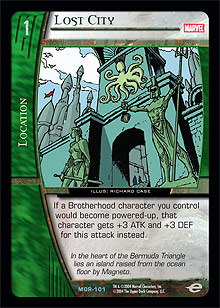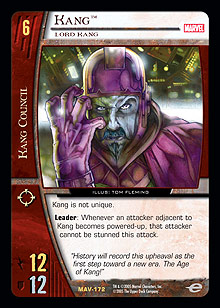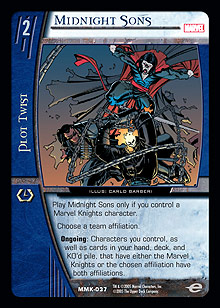Lost City is a card that players either love, or love to hate. It was the cornerstone of one of the earliest tier 1 decks in history, Big Brotherhood, where its synergy with Avalon Space Station was immediately apparent. It has shown up in all sorts of weirdness ever since, from Michael Jacob’s Force (the Longshot, Rebel Freedom Fighter–based deck) to the Arkham Inmates / Brotherhood mash-up bent on abusing Harley Quinn, Dr. Harleen Quinzel. Lost City has always been one of those intriguing cards that gives all of us ideas and makes us think.
 Lost City was necessarily limited by the number of characters with the same name that we could get into a deck. Sentinels / Brotherhood decks were built by many players but didn’t enjoy much success. Yet the idea of the team-up was so scary that it started the urban legendof the “Mark City” deck. Several of the Top 8 competitors at a $10K right before Pro Circuit: L.A. 2005 believed that the “Mark City” deck, featuring Lost City and Sentinel Mark V, was the best deck in Golden Age. This started a flurry of speculation and deckbuilding as players tried to decipher just what the deck actually was and if it was any good. Signs eventually pointed to no, but even the possibility of such a deck existing sent players into a cold sweat. A Lost City–based deck featuring Army characters never really worked out.
Lost City was necessarily limited by the number of characters with the same name that we could get into a deck. Sentinels / Brotherhood decks were built by many players but didn’t enjoy much success. Yet the idea of the team-up was so scary that it started the urban legendof the “Mark City” deck. Several of the Top 8 competitors at a $10K right before Pro Circuit: L.A. 2005 believed that the “Mark City” deck, featuring Lost City and Sentinel Mark V, was the best deck in Golden Age. This started a flurry of speculation and deckbuilding as players tried to decipher just what the deck actually was and if it was any good. Signs eventually pointed to no, but even the possibility of such a deck existing sent players into a cold sweat. A Lost City–based deck featuring Army characters never really worked out.
Eventually, though, there was a team that fit the Lost City strategy perfectly. It was a team that minimized the character replacement problems of running twelve Wolverines and ten Rogues, as well as the lack of different character costs when you chose to run sixteen Sentinel Mark Vs. It was a match made in heaven, and eventually in a $10K Top 8. It was brilliant. It was clever.
It was Kang.
Playing Kang with Lost City may be a bit obvious, but it’s also inspired. You got to play lots of Kangs, draw lots of cards, and stonewall any attack you felt like stonewalling. It was terrific fun. You got to play an 8-drop, for Pete’s sake. I was this close to taking this deck to PC: L.A. in 2005. It was ten times more fun to play than the anti-weenie Curve Sentinels build I actually took to the tournament.
There was only one problem: to play Kang City, you actually had to play a Brotherhood character. You didn’t want to play a Brotherhood character, though. They just detracted from the giant pile of Kangs. They had a name that wasn’t Kang. What fun was that? Luckily, Jason Tassitano found a convenient way around that little restriction.
Jason Tassitano
$10K Atlanta 2005
Characters
 2 Kang, Immortus
2 Kang, Immortus
2 Kang, Lord of Limbo
3 Kang, Lord Kang
3 Kang, Ultimate Kang
4 Kang, Master of Time
4 Kang, Kang Ransom
3 Kang, Kang Cobra
4 Kang, Kang Kong
3 Kang, Rama Tut
4 Dagger, Child of Light
3 Mikado and Mosha
Plot Twists
4 Psyche-Globe
4 Midnight Sons
4 Reconstruction Program
4 Wild Ride
Locations
2 Psychoville
4 Avalon Space Station
4 Lost City
There’s something inherently dishonest about playing a Lost City deck with exactly zero Brotherhood characters. But c’mon—it’s Kang. Since when does Kang play fair?
 The Midnight Sons engine is one of the most interesting groups of cards in Vs. System. It lets you do so many different things that it’s impossible to mention them all. This deck, though, was the most brutally simple use of Dagger, Child of Light and company ever to see play. The idea here was to team-up Marvel Knights, Kang, and Brotherhood by turn 4. That’s it. It’s your mulligan condition. Lost City is useless without teaming-up, so teaming-up is your main priority. After this is done, your Marvel Knights characters are completely useless and can be discarded to Avalon Space Station or Kang, Immortus at will.
The Midnight Sons engine is one of the most interesting groups of cards in Vs. System. It lets you do so many different things that it’s impossible to mention them all. This deck, though, was the most brutally simple use of Dagger, Child of Light and company ever to see play. The idea here was to team-up Marvel Knights, Kang, and Brotherhood by turn 4. That’s it. It’s your mulligan condition. Lost City is useless without teaming-up, so teaming-up is your main priority. After this is done, your Marvel Knights characters are completely useless and can be discarded to Avalon Space Station or Kang, Immortus at will.
Kang, Kang Kong allows you to search for Lost City. If you don’t have Lost City within the first three turns, you at least have to consider under-dropping Kang, Kang Kong and finding it. While the deck can win without Lost City, it’s a whole lot harder.
Kang, Kang Ransom is generally annoying. He will occasionally hide himself when you don’t want him to, but for every time he does that, he’ll replace your opponent’s The New Brotherhood or replace into a resource that the Quicksilver, Inhuman by Marriage deck can’t flip up. After he does that, he’s a 5 ATK / 5 DEF body and he’s named Kang. That’s enough.
Kang, Master of Time kick starts the card advantage engine. Between the Master of Time and Avalon Space Station, you’ll draw two extra cards a turn. Psyche-Globe, Wild Ride, and Reconstruction Program all provide a free card. After turn 4, your hand will be full to bursting with copies of Kang, ready to lay the power-up smackdown on the opponent.
Turn 5 brings Kang, Ultimate Kang. Ultimate Kang is a walking Heroic Sacrifice. You can generally force your opponent to make an utterly awful choice on turn 5: attack with his or her entire team into Kang, Ultimate Kang and get blown out by his ability; or don’t send enough and get blown out by Lost City power-ups, followed by an angry Ultimate Kang revenge attack. Since you play mostly hidden to get to this point, stonewalling and swinging back off-initiative will feel very, very good.
Kang, Lord Kang is the lord of turn 6. His ability is unimpressive, but he costs 6 and is named Kang. What more do you want? Kang, Lord of Limbo drops on turn 7 and cleans up. Kang, Immortus rarely lands on the table, but like a good security blanket, he’s there if you need him.
The locations and plot twists are simply there to facilitate the main goal of billions of Kang power-ups. Everyblue or green card in the deck is either Midnight Sons, Lost City, a way to find one of the above, or a way to draw a copy of Kang. Well, except Psychoville. Psychoville is a way to throw your 3-drop or 4-drop Kang back into the fight if he really needs to be there, along with a way to attack hidden characters that stymie your strategy, such as Kang, Kang Cobra. What a brutal piece of irony, huh?
Mr. Tassitano managed an 8-2 record on Day 1 of $10K Atlanta 2005 and had to face David De Michele in the quarterfinals, playing one of his worst matchups—the all-hidden MKKO deck. Jason took the match to three games before Luke Cage and company finished him off. Still, the Kang City deck did exactly what he intended it to do. It took him to Top 8 glory with a hilariously unexpected and powerful deck.
As a TCG grows, it becomes harder and harder to look back through all the cards that have ever been created to find a powerful interaction. At the release of The Avengers, roughly 1,500 Vs. System cards had been printed. Now there are over 3,000. Finding synergy between Frankie Raye ◊ Nova, Optimistic Youth; Deadshot, Floyd Lawton; The Phantom Stranger, Wandering Hero; Mr. Mxyzptlk, Troublesome Trickster; and Dr. Light, Master of Holograms, which are all from different sets, may be the key to winning yourself $40,000. Adam Prosak recently discovered this. Or, you might find that Ahmed Samsarra and Merlyn, Deadly Archer complement each other smoothly enough to win the big check, as Ian Vincent discovered.
In fact, an interaction with an older card can be the backbone of some of the best rogue strategies. You can build a rogue deck that no one has ever seen before, which will both impress people and confuse them, thus allowing you to win matches you might not have otherwise. Nobody expects the Spanish Inquisition! Um, I mean nobody expects that Superman, Man of Steel card to be played out of your Marvel Team-Up deck. Look back for inspiration. You might be surprised at what you find.
Keep in mind that in the current Silver Age, Green Lantern Corps is the oldest set you can play with. Does anyone think Qwardian Pincer could be playable in a Kree / VU deck? What about ¡Ole! and Shock Troops? What about Emerald City? Ego Gem along with Birthing Chamber should be enough to discard three cards every turn, and you can play the aforementioned Mr. Mxyzptlk, Troublesome Trickster. These are the kinds of decks that will get your City Championship noticed by UDE.
Or you could play Kang.
Until next time,
Mark Slack
ms243@evansville.edu